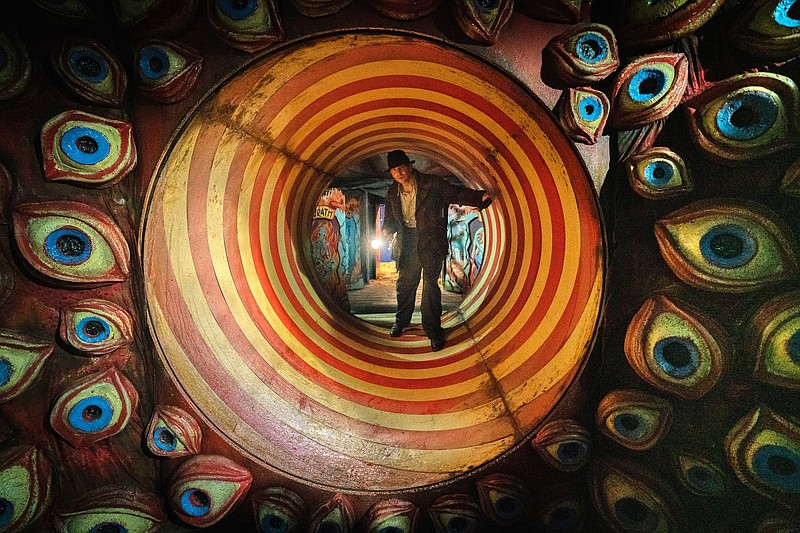In the opening scene of Guillermo del Toro's new film "Nightmare Alley" we watch a man dragging a dead body, tightly wrapped in a bed sheet, across the dusty floor of a remote ramshackle farm house. He strikes a match and sets the place ablaze. The man makes his way to a bus station where, once onboard, he lowers his floppy brimmed fedora over his tired heavy eyes and falls asleep, only waking up when the bus reaches the proverbial "end of the line."
In many ways that opening sequence encapsulates del Toro's latest effort. I won't get into details, but the general arc of the story (penned by del Toro and Kim Morgan) is baked into those mysteriously framed and exquisitely detailed first few minutes. And while the intro feels very much like classic del Toro, "Nightmare Alley" sees the filmmaker stepping away from the supernatural and giving us something that feels carved right out of 1940s Hollywood.
As you would expect from a del Toro film, "Nightmare Alley" is a visual feast, anchored by Tamara Deverell's sparkling production design. It also brings together a stellar ensemble that includes Bradley Cooper, Cate Blanchett, Willem Dafoe, Toni Collette, Rooney Mara, Richard Jenkins, Ron Perlman, David Strathairn, Mary Steenburgen and Tim Blake Nelson. So automatically you have a movie loaded with talent in front of and behind the camera.
This pulpy neo-noir thriller (adapted from William Lindsay Gresham's 1946 novel of the same name) tells the story of Stan Carlisle, the man from the film's cryptic opening. He's played by Cooper who (aside from his come-and-go Southern drawl) is a nice fit playing a beguiling drifter packing a lot of mystery behind his disarming good looks. The moment he steps off the above mentioned bus, del Toro begins to unpack Stan's story, and the first half of this overly long but mostly riveting two-parter kicks into gear.
It's 1939, Hitler is set to invade Poland, and once again the world is about to be plunged into war. Different radio broadcasts and newspaper reports about the war are scattered throughout the movie. They provide the timeline for Stan's story which begins in earnest when he happens upon a traveling carnival ran by a crusty barker named Clem (Dafoe). "Folks here don't make no never mind to who you are or what you've done," Clem declares as he offers the desperate Stan some steady work. It happens to be the perfect scenario for someone on the run from his skeleton-filled past.
As Stan works his way up the ragtag carnival's ranks he grows closer to several of the chief acts including the "mind-reading" Zeena (an underused Collette) and her hard-drinking ex-mentalist husband Pete (the always terrific Strathairn). Sensing an opportunity, Stan begins picking their brains and learning the secrets behind their ruse. But it's a quiet young performer named Molly (a tender and understated Mara) who really grabs his attention. She eventually takes a liking to Stan much to the chagrin of Bruno (Perlman), the carnival's strongman and Molly's self-appointed guardian.
While the first half of the movie thrusts us into its roadshow milieu, the slow-burning second half pulls us in a much different direction. Del Toro leaves the muddy open fields and cheap lights and takes us to big city Buffalo, bathed in early '40s art deco and dripping with high society excess. This part of the story picks up two years after Stan and Molly ran away together. Now, instead of creaky makeshift carnival stages under the night sky, the couple work ballrooms, performing their own psychic bit in front of the city's rich and privileged.
More con man than showman, Stan's ambition is only outdone by his conceit. Soon he's buying into his own press and this huckster who once hid in society's shadows now basks in its limelight. But then he meets the story's femme fatale, Dr. Lilith Ritter (a smoldering Blanchett). She's a psychologist who immediately sees through Stan's act. Soon the two are using their own special brands of con artistry to swindle their wealthy targets. But who can trust whom in this dubious partnership?
I've never seen Edmund Goulding's generally well-regarding 1947 film adaptation, but the del Toro version highlights the filmmaker's knack for immersive world-building. Every frame of his dark and sometimes twisted fable has something alluring to see and absorb. And every member of his superb ensemble is a good fit and brings his seedy world texture to life. Even as the film stalls a bit in its second half, del Toro's world remains a compelling place to be.
"Nightmare Alley" is a nice step up from del Toro's last film, the pretty but hole-filled Best Picture winner "The Shape of Water." And while it does see him step away from the supernatural, this is still a movie full of monsters. It's essentially a cautionary tale that explores the dark side of human nature (which is nothing new for the 57-year-old filmmaker). It's also top-notch cinema, bursting with style and grounded in the kind of grim and grimy atmosphere that should leave old-school noir fans giddy.
More News
None‘Nightmare Alley’
89 Cast: Bradley Cooper, Cate Blanchett, Rooney Mara, Richard Jenkins, Toni Collette, Tim Blake Nelson, Willem Dafoe, Ron Perlman, David Strathairn, Mary Steenburgen
Director: Guillermo del Toro
Rating: R, for strong/bloody violence, some sexual content, nudity and language
Running time: 2 hours 30 minutes
Playing theatrically.
